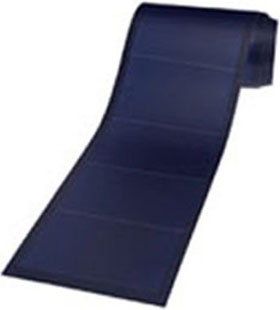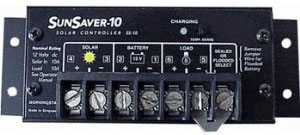Generators are noisy and smelly, and they can be expensive. A simple backup power system that uses a battery costs much less. It won't run a fridge -- but it will keep your mobile devices charged, and it can also be used as an emergency car starter. Of course, the battery's own life is limited, but you can add a solar panel to the system to keep your gadgets charged indefinitely.
Return to the battery article for a refresher on amp hours if you need it -- but a 55-aH battery like the Optima we used can comfortably pair with a 55-watt, or slightly higher output panel.
A flexible laminate amorphous panel like the one we're using here pumps out 68-watts in full sun.
 Flexible panels are great for backup power because you can fold them or roll them up until you need them. They are also harder to break, unlike like the permanent-install glass types. The problem is that foldable panels are generally very expensive.
Flexible panels are great for backup power because you can fold them or roll them up until you need them. They are also harder to break, unlike like the permanent-install glass types. The problem is that foldable panels are generally very expensive.
I have sourced a cheap rollup panel, manufactured by now-bankrupt Uni-Solar, that was designed for sticking to metal roofs.
I recommend it for this solution. The U.S.-based company went bust partly as a result of cheap imports and slowing economy -- not because the product was no good. Obtain one from SoldonSun (about US$189 on Amazon and eBay).
Tip: Two 30-foot runs of solar-specific extension cable are useful if budget allows, so you can keep the battery in the protective shade (about $44 at Amazon).
Charge controllers stop the battery from becoming overcharged -- and consequently damaged -- by limiting the output of the panel. They can also perform neat battery tricks like interrupting power to the load in the event of low battery.

I'm using well-regarded Morningstar's SunSaver 10 amp controller (about $48 on Amazon through SoldonSun).
Tip: The charge controller should exceed the output of the panel by at least 25 percent.
A rough, ballpark calculation for the controller is to divide watts-by-voltage to get the amps delivered by the panel. In this case, dividing 68 by 12 provides 5.66 amps.
Check with your manufacturer, though, because solar panels will provide more than 12 volts under certain conditions, thereby increasing the amp load, resulting in beefier charge controller needs.
Other parts you will need: 12-AWG automotive wire, called "primary wire"; a pair of battery terminals -- the marine kind with wing nuts is best for this job; yellow color-coded wiring spades; large ring terminals and butt connectors; two pigtailed automotive-style fuse holders; two maximum 20-amp fuses; and associated tools like probe voltmeter, wire stripper and crimper.
You can source all of these materials from automotive stores like Autozone and electronics stores like Frys.com.
The Load
First, cut the alligator clamps off the end of the cigarette lighter plug we used on the battery project and discard the clamps.
Then strip a quarter-inch from the ends of the retained wires and join a fuse-holder pigtail to the red, positive lead with a butt connector. I get aesthetically fancy here and also heat-shrink the connection, but you don't have to.
Add one spade to the other end of the positive fuse-holder pigtail and one spade to the end of the black lead from the cigarette lighter.
Attach the black lead to the controller's negative screw labeled "Negative Load" or similar, and the red to the positive screw labeled "Positive Load."
The cigarette lighter plug is now connected to the charge controller.
The Solar Panel
Cover the panel with its shipping paper, or roll it on itself to avoid arcing cables, and then hook the solar panel to the "Solar" terminals on the charge controller.
Hard-to-work-with solar-specific MC3 plugs are commonly supplied in this environment.
However, you can just snip the MC3 ends off solar-specific cables at the charge controller end, and crimp spades to make the connections if you want. No fuse is required here.
Tip: Check for polarity with your multimeter probes and multimeter set to DC before connecting. Expose a little of the panel to generate some power, and check for a negative symbol in the multimeter display that indicates incorrect polarity. Correct if necessary.
The Battery
Follow the wiring technique instructions in the earlier "Load" paragraph to make battery connections for the controller terminals labeled "Battery."
Add a pigtail fuse holder on the positive wire within 6 inches of the battery. Crimp ring terminals and then connect the black and red wires under the corresponding battery wing nuts -- positive first and then negative.
Then insert the fuses, inserting load circuit fuse first, then battery circuit. Observe the power-up light sequence from the charge controller's manual.
Plug your phone charger into the cigarette lighter socket along with phone, and watch the phone's charging-in-progress indicator -- forever.
Tip: Amorphous panels like the one mentioned will work in shade -- it'll just take longer to charge the battery.
A few weeks ago, I wrote about building a simple, home backup power system for charging phones during extended electricity outages -- like that which occurred during storm Sandy.
However, there's a limitation to any battery system, and that is that any battery power supply will eventually become depleted. I reckon to get a theoretical 13 days out of mine. What happens, in a catastrophic event, if grid power isn't restored at the end of 13 days?
The answer is pretty simple. It's simple to harness the sun's rays and keep the battery topped up with an electricity-producing photovoltaic solar panel.
Here's how to go about it.
Step 1: Calculate Your Needs
Match the solar panel to the battery. Solar panel output is measured in watts. A rule of thumb is to choose a panel with roughly the same number of watts as the battery has amp hours.Return to the battery article for a refresher on amp hours if you need it -- but a 55-aH battery like the Optima we used can comfortably pair with a 55-watt, or slightly higher output panel.
A flexible laminate amorphous panel like the one we're using here pumps out 68-watts in full sun.
Step 2: Choose Your Panel
Portability and cost are the two major factors. All panels at the low end of wattage output, like the one we're working with, output at 12 Volts DC -- correctly matching the voltage of the battery.
UniSolar Flexible Solar Panel
I have sourced a cheap rollup panel, manufactured by now-bankrupt Uni-Solar, that was designed for sticking to metal roofs.
I recommend it for this solution. The U.S.-based company went bust partly as a result of cheap imports and slowing economy -- not because the product was no good. Obtain one from SoldonSun (about US$189 on Amazon and eBay).
Tip: Two 30-foot runs of solar-specific extension cable are useful if budget allows, so you can keep the battery in the protective shade (about $44 at Amazon).
Step 3: Gather the Rest of the Parts
Predominantly, you'll need a charge controller.Charge controllers stop the battery from becoming overcharged -- and consequently damaged -- by limiting the output of the panel. They can also perform neat battery tricks like interrupting power to the load in the event of low battery.

Morningstar SunSaver Charge Controller
I'm using well-regarded Morningstar's SunSaver 10 amp controller (about $48 on Amazon through SoldonSun).
Tip: The charge controller should exceed the output of the panel by at least 25 percent.
A rough, ballpark calculation for the controller is to divide watts-by-voltage to get the amps delivered by the panel. In this case, dividing 68 by 12 provides 5.66 amps.
Check with your manufacturer, though, because solar panels will provide more than 12 volts under certain conditions, thereby increasing the amp load, resulting in beefier charge controller needs.
Other parts you will need: 12-AWG automotive wire, called "primary wire"; a pair of battery terminals -- the marine kind with wing nuts is best for this job; yellow color-coded wiring spades; large ring terminals and butt connectors; two pigtailed automotive-style fuse holders; two maximum 20-amp fuses; and associated tools like probe voltmeter, wire stripper and crimper.
You can source all of these materials from automotive stores like Autozone and electronics stores like Frys.com.
Step 4: Hook It All Up
There is an order to all of this -- fuses being last.The Load
First, cut the alligator clamps off the end of the cigarette lighter plug we used on the battery project and discard the clamps.
Then strip a quarter-inch from the ends of the retained wires and join a fuse-holder pigtail to the red, positive lead with a butt connector. I get aesthetically fancy here and also heat-shrink the connection, but you don't have to.
Add one spade to the other end of the positive fuse-holder pigtail and one spade to the end of the black lead from the cigarette lighter.
Attach the black lead to the controller's negative screw labeled "Negative Load" or similar, and the red to the positive screw labeled "Positive Load."
The cigarette lighter plug is now connected to the charge controller.
The Solar Panel
Cover the panel with its shipping paper, or roll it on itself to avoid arcing cables, and then hook the solar panel to the "Solar" terminals on the charge controller.
Hard-to-work-with solar-specific MC3 plugs are commonly supplied in this environment.
However, you can just snip the MC3 ends off solar-specific cables at the charge controller end, and crimp spades to make the connections if you want. No fuse is required here.
Tip: Check for polarity with your multimeter probes and multimeter set to DC before connecting. Expose a little of the panel to generate some power, and check for a negative symbol in the multimeter display that indicates incorrect polarity. Correct if necessary.
The Battery
Follow the wiring technique instructions in the earlier "Load" paragraph to make battery connections for the controller terminals labeled "Battery."
Add a pigtail fuse holder on the positive wire within 6 inches of the battery. Crimp ring terminals and then connect the black and red wires under the corresponding battery wing nuts -- positive first and then negative.
Step 5: Find a Sunny Spot
Place the solar panel in a maximum sun location, avoiding shade. Place the battery and charge controller next to each other in the shade, observing any heat-reducing orientation requirements from the charge controller's instruction manual. I've mounted mine vertically on the side of a battery box.Then insert the fuses, inserting load circuit fuse first, then battery circuit. Observe the power-up light sequence from the charge controller's manual.
Plug your phone charger into the cigarette lighter socket along with phone, and watch the phone's charging-in-progress indicator -- forever.
Tip: Amorphous panels like the one mentioned will work in shade -- it'll just take longer to charge the battery.

















0 comments:
Post a Comment